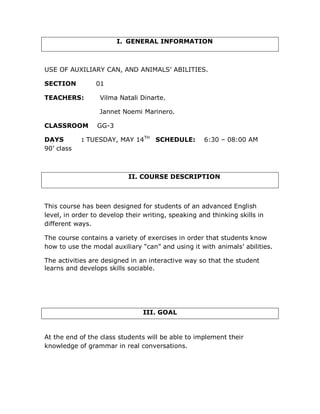Ict
- 1. I. GENERAL INFORMATION USE OF AUXILIARY CAN, AND ANIMALSŌĆÖ ABILITIES. SECTION 01 TEACHERS : Vilma Natali Dinarte. Jannet Noemi Marinero. CLASSROOM GG-3 DAYS : TUESDAY, MAY 14TH SCHEDULE: 6:30 ŌĆō 08:00 AM 90ŌĆÖ class II. COURSE DESCRIPTION This course has been designed for students of an advanced English level, in order to develop their writing, speaking and thinking skills in different ways. The course contains a variety of exercises in order that students know how to use the modal auxiliary ŌĆ£canŌĆØ and using it with animalsŌĆÖ abilities. The activities are designed in an interactive way so that the student learns and develops skills sociable. III. GOAL At the end of the class students will be able to implement their knowledge of grammar in real conversations.
- 2. LEARNING OBJECTIVES ’é¼ Students will be able to describe some abilities that animals have using the auxiliary can in a spoken way. ’é¼ Students will be able to use the content learned by writing about animals and their abilities. ’é¼ Students will be able to extend their knowledge about the use of auxiliary can IV. METHODOLOGY The methodology that is going to be use to develop this course is a combination between two methods, ŌĆ£the Audio Lingual method and the Communicative approachŌĆØ. Students need to be exposed to the language as much as possible. Also because of the level that the students have, it is necessary to teach them about some grammar structures regarding to this auxiliary, during the development of the course student will be expose to technology, (multimedia projector, computer, online games, videos, an power point presentations). Students perform during the class needs to be at 100%, in order to get them familiar with the use of this auxiliary.
- 3. Development Resources. Time. Evaluation. Warm up: Teacher will ask to Multimedia Online quiz, students to pass in front of Projector. using the the class, and he will auxiliary ŌĆ£canŌĆØ command some actions Laptop. Flashcards. 5 minutes. that every student has to perform for example Board. (Jump, scratched). Markers. Games. Introduction. (Video Videos. Check studentsŌĆÖ about finniest things participation. Power Point 10 minutes. animals do.) Presentation. ’é¼ Presentation: Demonstrate the use of ŌĆ£canŌĆØ by showing some flashcards, using animalsŌĆÖ abilities. (Positive, Check the 20 minutes. negative and questions accuracy of forms.) (Grammar.) students according to the use of the Auxiliary ŌĆ£can,ŌĆØ will be auxiliary can. presented using a power point presentation. 10 minutes. ’é¼ Practice: Fill in the blanks (through some exercises on the board
- 4. Students will make groups 5 minutes. Quiz about what (3 ŌĆō 5 students), then they some animals will- express which can do and what abilities their pets have or they cannot do. donŌĆÖt have, using can, or canŌĆÖt. 10 minutes. In groups students will imagine/invent a new kind of pet, and they will assign it some abilities, then they will present the new pet to the rest of the class, the 15 minutes. most creative pet will be the winner, (a gift is being giving to the group.) ’é¼ Product: A learner will pick up a flash card, and will talk 10 minutes. about it in front of the class. 5 minutes. The student will describe the animal abilities using auxiliary can.
- 5. VII. BIBLIOGRAFY ’é¦ Author: Dooley, Jenny; Evans, Virginia ’é¦ Title: blockbuster student book. 1. ’é¦ Publishing company: Express Publishing. ISBN: 1845581989 ’é¦ Type: English language - text books for foreign speakers. Grammar, vocabulary, reading, writing, dialogues.





